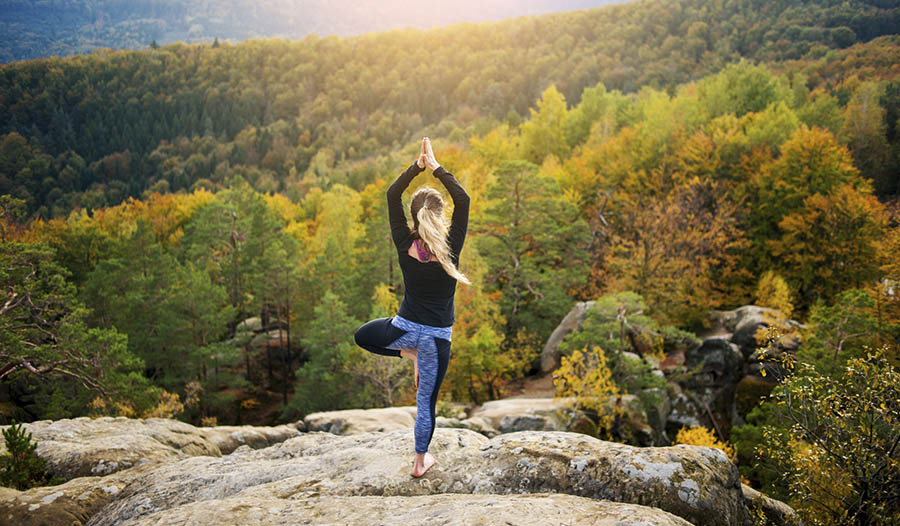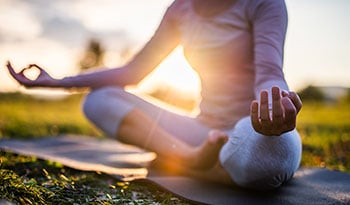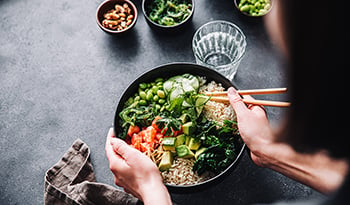Ayurvedic Tips for Finding Balance in the Fall
DISCLAIMER:This blog does not intend to provide diagnosis...
- In this article:
- 1. Cleanse and protect the sinuses
- 2. Scrape the tongue
- 3. Eat warm food
- 4. Slow down
- 5. Drink chai
- 6. Eat a sleep snack
- 7. Moisturize with healthy fats
- 8. Get an oil massage
- 9. Meditate
- 10. Sweat everyday
- 11. Stop and smell
- 12. Keep the body warm
- 13. Pour the vinegar

1. Cleanse and protect the sinuses
Renowned Ayurvedic practitioners recommend the nasya, nasal application of medicinal powders and oils, and neti wash, a simple method of nasal irrigation, to treat and prevent colds. The neti wash helps flush out excess mucus, viruses, bacteria, and dust. Mix a quarter teaspoon of non-iodized salt into a cup of pre-boiled, distilled, or filtered water into a neti pot. Insert the tip of the neti container into the upper nostril while bending over a sink and tilting the head slightly sideways. Let the saline flow through the nasal passage and out through the lower nostril. Repeat this procedure thrice on each nostril while blowing the nose gently to eliminate mucus from the nasal passages. Studies show that saline nasal irrigation helps fight against colds, seasonal allergies, and chronic sinus symptoms. It also helps prevent the recurrence of flu and colds in children.
2. Scrape the tongue
Ayurveda states that one can learn a lot about what is happening in his or her body by observing the characteristics of the tongue. It can even help someone know how he or she needs to start the day. A body with a clear digestive tract and healthy organs has a pretty pink tongue. However, a body with undigested food and clogged organs has a layer of film, fuzz, and bumps other than the taste buds. The presence of the latter on the tongue indicates that one has toxins in the body that he or she needs to get rid of. To eradicate them, it’s important to detox by drinking detoxifying juices, getting a full cleansing, or seeking the help of a qualified Ayurvedic practitioner for an individualized regimen. However, first, scrape off the toxins from the tongue to prevent returning them into the digestive system. To achieve this, use the edge of a stainless spoon or a tongue scraper. One can purchase a tongue scraper online or from most health food stores. Stainless steel scrapers are the most suitable because they do not rust. So, scrape the tongue gently from the back to the front to get it clear and clean.
3. Eat warm food
Thoroughly cook meals and serve them warm during the autumn. Avoid dried foods such as popcorn, crackers, granola bars, fruits, and nuts. Also, avoid raw smoothies, salads, and juices. It is crucial to follow one’s instincts and increase the intake of porridges, broths, soups, and stews, especially those containing root vegetables. It is also helpful to use warming spices such as ginger, fennel, turmeric, cinnamon, and cardamom.
4. Slow down
When a vata imbalance occurs, it is time for the body to move more slowly. Take it easy on workouts at the gym. Avoid extended, static stretches that are depleting and strenuous. Instead, focus on exercises that build stability and strength around the joints. Try yoga, long walks, and bike rides.
5. Drink chai
Buy some holy basil tea, also known as tulsi, from a health food store nearby. For coffee drinkers, a good choice is to make chai tea with milk and sweetened with honey since coffee is bitter and it antagonizes the vata. Also, avoid chilled water and cold beers as they tend to slow down food digestion.
6. Eat a sleep snack
Taking warm milk and honey before going to bed is beneficial for vata. Adding some warming spices helps in grounding, and the protein helps relax the body before going to sleep.
7. Moisturize with healthy fats
Increasing one’s healthy fat intake is vital. Since vata foods are dry, eat foods that moisturize the body from the inside out. Among the most excellent choices are ghee, coconut oil, flax seed, and avocado. For vegans, the best option is coconut milk. Dairy will work well for others.
8. Get an oil massage
An oil massage relaxes the nervous system, nourishes the skin, feeds the inner body tissues, and eliminates impurities from the blood. Just as a machine requires greasing, our bodies need to be oiled to protect them from the wear and tear of the environment and also just for pleasure. Here are some of the best oils for each dosha:
- Vata—almond and sesame oil
- Pitta—olive and coconut oil
- Kapha—grapeseed and sunflower oil
When rubbing these oils directly onto the skin, use cold-pressed, organic oils. One should set up the bathroom, get into the tub, and fill it with a few inches of water to keep the body warm while massaging his or her body. This prevents a mess elsewhere in the house.
Gently warm the oil before starting by pouring a quarter cup of oil into a transparent plastic squeeze bottle. Put the bottle in a cup of simmering water and let it sit until it is warm. One should ensure he or she has a clean towel to wipe the body after the bath.
Ayurvedic massage is done with the fingers as well as the palms and balls of the hand. Use circular strokes on the abdomen and joints and up-and-down strokes on the limbs. After finishing, leave the oil on the body for 30 minutes, then take a hot bath or shower. The hot water loosens up the pores on one’s skin and enables the oil to penetrate the deeper tissues of the body.
However, if one cannot give himself or herself this particular treatment, book an appointment for a massage and ask the practitioner to use sesame or almond oil.
9. Meditate
Take the time to meditate. Sometimes, the mental chatter of the vata mind can be quite unbearable. Thus, to prevent the occasional overwhelming waves of anxiety, start the day with a 15-minute meditation session. Meditation is among the essential practices in life. However, it is often the easiest to miss. Taking the time to be mindful every day can significantly enhance well-being.
10. Sweat everyday
Sweating, also referred to as svedana, is an excellent complement to any cleansing regimen, and it helps detoxify the system on a higher scale. The best way to accomplish this is by taking a ginger bath, steam, or sauna. In the autumn, dryness is prevalent. Thus, it is crucial to have an oil massage immediately before or after the sweating to prevent dehydration. Apply one of these sweating techniques daily for three to seven days before cleansing the body, every day during the cleansing, and three times a week after cleansing.
11. Stop and smell
Naturally occurring essential oils found in the flowers, bark, roots, and stems of particular plants have been traditionally used to treat physical and emotional imbalances. Their aromatic qualities can be quite stimulating or relaxing. Setting a few drops on one’s pulse points or just sniffing them can be very therapeutic.
12. Keep the body warm
It is essential to keep the body warm. Wear layered clothes, take a relaxing bath using bath oils, bath salts or even just a bubble bath before going to bed, and when outdoors, wrap a scarf around the neck because the throat is highly vulnerable to cold.
13. Pour the vinegar
For optimal hydration, drink more fluids but skip the ice. It is easier for one’s cells to absorb warm water, but fizzy, chilled beverages impede one’s digestion. First thing in the morning, take hot water with grated ginger, lemon, and a dash of apple cider vinegar to hydrate and alkalize the body. Throughout the day, drink room-temperature water, and in the evening, drink herbal teas.
Autumn is a season that is often accompanied by colds, flu, and all manner of sinus infections. However, following the above advice to prep for the cold season will help prevent these problems and remain healthy throughout the season. So, cleanse and protect the sinuses, eat warm food, meditate, and get a massage to stay healthy.




